Blanquefort, Gironde, Nouvelle-Aquitaine 作者: 来源: 发布时间:2021-04-06
I. Population and Area
Total Area: 33,72 km2 (13.02sq mi)
Population in 2017: 15 833
Population Density: 470/km2 (1216/sq mi)
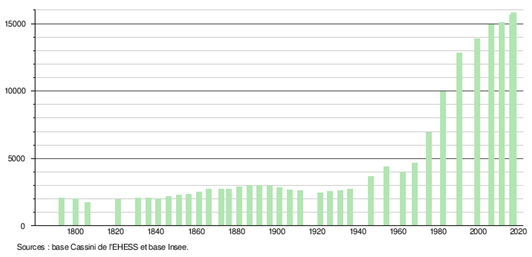
Histogram of demographic change
II. Natural Geography (environment and resources)
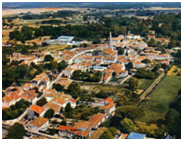
Blanquefort (Blancahòrt en gascon) is a commune in south-west France, located in the department of Gironde in the Nouvelle-Aquitaine region.Its inhabitants are called the Blanquefortais.
Location:
Municipality of the urban area of Bordeaux located in its urban unit which has 3,372 hectares but a large part is inconstructible. Indeed, the eastern half, near the Garonne and the Jalle de Blanquefortriver is made up of ancient marshes. These were drained from the 17th century by the Dutch, but they still remain flood-prone areas. This part of the town therefore serves as meadows for some livestock. A gravel extraction quarry is installed there; it dug the second largest body of water in the Bordeaux suburbs.
The eastern half of the town is divided between vast woods, notably that of Tanaïs, viticulture, and inhabited areas. Wine chateaux are still an important activity of the city today and contribute to the structure of the landscape. Château Dillon was thus integrated into an agro-viticultural high school in 1923.
After rapid growth during the 1970s and 1980s, the city's population seems to be stagnating even if it remains young. There are numerous educational establishments, both public and private. The demographic growth pushed the city to acquire socio-cultural infrastructures like the center of the Columns, at the same time media center and cinema. It illustrates the urbanization of the city center with medium-sized collective complexes, while in the rest of the commune dominates an individual suburban housing structured in subdivisions with curvilinear roads.
Green spaces have a particular importance also in the city which seeks to maintain a rural aspect. Majolan Park was built at the end of the 19th century in a romantic style. Around a vast body of water, caves and artificial ruins, the park is one of the popular walking places for residents of the Bordeaux area.
Access by the ring road: exit Exit 06 Bruges-Blanquefort-ZI Campilleau.
Access by the ring road: exit exit 04a StadeAtlantique-Parc Expositions-Bruges bypassing the National Natural Reserve of the Marshes of Bruges.
Public transport:
1. TBM network:
TBM network map in Blanquefort
1) The Transport Bordeaux Métropole (TBM) network serves the town through bus lines 22, 37, 38 and 77 and 78. In the evening, the town is served by Flexo 57 and line C of the tram.
2) The extension of line C of the tramway put into service in 2016 makes it possible to connect Blanquefort station to Bordeaux. A second tram stop serves Blanquefort: the Frankton stop.
2. Trans Gironde network:Line 704 leaves from the station to Arsac, line 705 leaves from Place Ravezies-Le Bouscat to Pauillac, Saint-Estèphe and Cissac-Médoc.
3. Train:Blanquefort train station is served by the Médoc line.
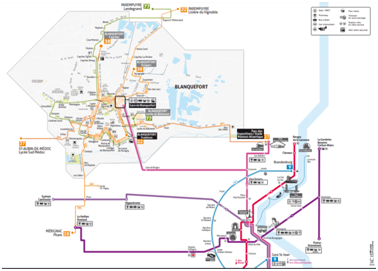
Blanquefort station on the Médoc line
III. ECONOMY
Employment income (%): 74.4 (2016)
Poverty rate by age group of the tax advisor(%): 10 (2017)
Average employment income (€):2 555 net per month (30 663 net per year)(2014)
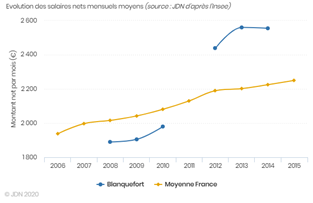
Evolution of average monthly net wages
Sources : http://www.journaldunet.com/business/salaire/blanquefort/ville-33056
https://insee.fr/fr/statistiques/2011101?geo=COM-33056#chiffre-cle-5
IV. Industrial Characterisitics
For years, the gearbox factory of Ford Aquitaine Industries (FAI), established since 1972 in Blanquefort, has been the largest factory in Aquitaine. In 2009, HZ Holding France, associated with the German group Johann Hay took over the factory which was renamed First on occasion, by proposing several industrial projects. In 2010, the latter seeming to be unsuccessful, the unions launched an alert procedure. Finally, Ford reversed its decision in June 2011 and bought its old factory, now 955 jobs out of the 1,500 on the site. It definitively stopped its production on July 24, 2019, the epilogue of more than a year of social conflict to try to prevent the closure of this site which had employed up to 3,600 employees.
Among other companies: GCastel frères, Bardinet, Labso fine chemicals, Simply Market, Aqmo, naval transport, France Sécurité, First Aquitaine industries and CESI.
Ecoparc project: reference site for sustainable economy, piloted by the city of Blanquefort, with the support of the CUB, the Gironde general council and the Aquitaine regional council. The project promotes both economic development and an environmental quality approach around a park dedicated to eco-industries and eco-activities.
In 2010, the median tax income per household was € 32,345, which placed Blanquefort at 10,160th rank among the 31,525 municipalities of more than 39 households in mainland France.
V. Attractions
1. Château Dillon (Chateau Dillon)
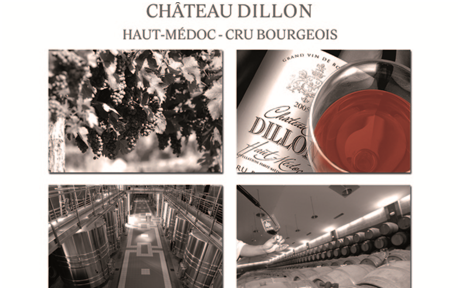
Château Dillon is a chateau and a wine-growing estate located in the commune of Blanquefort in Gironde in the Haut-Médoc Cru Bourgeois appellation.
Château Dillon, an eminent wine house and producer of Bordeaux wine in the Haut-Médoc district since 1932, steps onto the famous road of the Médoc châteaux.More than just a wine estate, the château hosts training and preparation for students in the agro-viticulture college of Bordeaux-Blanquefort.
History:
A fortified house, the Château Terrefort, existed at this place, the place called Terre-Fort.
Château Dillon was built at the end of the 17th century and at the very beginning of the 18th century and the well bears the date 1705. The castle was modified at the beginning of the 19th century.
Property of the Ministry of Agriculture and Forestry, it has become an agricultural high school, the LycéeViticole de Blanquefort.
It was listed as a historic monument on December 5, 1984.
Architecture:
The castle has remarkable elements including the entrance gate, its gate and a well.
The facades and roofs are also listed historic monuments as well as the stairwell, the staircase and its wrought iron banister as well as stucco decorations and a fireplace on the ground floor.
Winery :
Château Dillon is an AOC Haut-Médoc wine, cru Bourgeois red
On an area of 40 ha of gravel and clay-limestone soil, vines are planted, mainly Cabernet Sauvignon (52%) and Merlot (41%) but also Petit Verdot (6%) and Carmenere (1 %). The annual production is 250,000 bottles.
Since 2004, the entire site has been ISO 14001 certified.
Agricultural school:
A school for disabled persons was created in 1917 and then received on July 20, 1923 the status of School of Agriculture, Viticulture and Horticulture in Blanquefort in the Béchon and Bouchon areas. To increase the surface area, the neighboring lands of Château Dillon, which then belonged to Marie-Jeanne Seignouret, were rented on November 16, 1923. The "Château Dillon" cru was already known and classified as the 1st bourgeois cru of the Médoc. In 1953 the Ministry of Agriculture bought the land. Became Regional School of Agriculture on December 2, 1955, it was transformed into the LycéeAgricole de Bordeaux-Blanquefort on April 21, 1963 better known as the Lycéeviticole de Blanquefort, which provides teaching from the second to higher education.
ADDRESS
Rue Arlot de Saint Saud
33290 BLANQUEFORT
Bordeaux Porte du Médoc
CONTACT
chateau-dillon@chateau-dillon.com
+33 5 56 95 39 94
LANGUAGES
French and English
2. Château de Blanquefort (Blanquefort Castle)
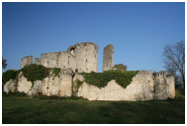
The Château de Blanquefort is a medieval fortress erected between the 11th and 15th centuries in the town of Blanquefort in the Gironde department of France, and today in ruins.
The archaeological interest of the site:
The fortress of Blanquefort presents a certain archaeological interest. It is one of the first medieval French monuments to have been classified as a Historic Monument, in 1862, on the recommendation of Prosper Mérimée.
The first archaeological site was opened in 1962. Five campaigns, carried out between 1966 and 1975, supplemented by regular works of safeguard and restoration revealed an important archaeological furniture:
1. ceramics: from proto-historic times to the present day (a house of medieval origin was rehabilitated around 1900 to house sharecroppers)
2. glasses: luxury items, often colored, which express the richness of the occupants
3. elements of military life: artillery bullets by the dozen, cannon, various weapons
4. elements of daily life: bone needles, gold rings, spindle whorls…
5. coins: several dozen coins from the Lower Empire to Louis XIV via Eleanor of Aquitaine, coins from Spain, France, England, Germany
6. architectural elements: in particular an exceptional collection of 14th-century paving tiles, one of the richest in France.
“The castle of Blanquefort was considered until the time of the Fronde as one of the most important places of war in Guienne. Now it is one of the most beautiful ruins. "- LéoDrouyn.
Sources :https://www.bordeaux-tourism.co.uk/offre/fiche/chateau-dillon/DEGAQU033FS0004Q
VI. History
The first traces of occupation date back to proto-historic times. In the Bronze Age (1500 BC) habitats existed near the river which borders the town to the south, the Jalle de Blanquefort. Ceramics have been found along the river and on the site of the medieval fortress.
The same site was occupied in Roman times since tegulae (Roman tiles) and coins were found there during excavations. The building, of which there are no other traces, was probably a guard post or a toll because located on the Roman road connecting Burdigala (Bordeaux) to Noviomagus in the Medoc.
The village already existed in the High Middle Ages, as evidenced by the presence of Merovingian sarcophagi in the foundations of the church. In addition, the cult building was dedicated to Saint Martin, the evangelizer of Gaul, which suggests a distant origin.
In the middle of the 11th century, lords established themselves and built a first stone castle, in the Romanesque style. It probably follows a primitive wooden dungeon. The castle is built on the road from Bordeaux to Médoc, a strategic axis on which the lord collects rights of way. Established in the middle of the marsh, the white building - because it was built in limestone - left its mark on a time when even the churches were still made of wood. It gives its name to the city: Blanquefort is the blancafortis, that is to say the "fort blanc".
In the 13th century, the castle became the property of King Edward I of England, who was also the Duke of Aquitaine. The castle was ceded soon after to the powerful Durfort family who kept the fortress until the French Revolution. At the beginning of the 14th century, the Durfort family was Guyenne's most powerful and they represented the king in his absence. Blanquefort is their main possession. The seigneury then includes a third of the Médoc, reaches the Atlantic Ocean and the Arcachon basin.
The small castle was then enlarged to become a royal English fortress responsible for defending Bordeaux against an attack by the King of France. Blanquefort becomes a strategic place of the Hundred Years War. A stone enclosure is built; the keep is enlarged by the addition of six large towers.
At the same time, other more modest castles appear on the current commune, like in Breillan or Terrefort. A chapel is built further north, in the village of Caychac.
In 1453, after the French victory of Castillon, the fortress was taken, before Bordeaux fell. It is the end of the Hundred Years War. For a few years, the castle became a French royal fortress, the possession of Louis XI. Then one of his lieutenants, Antoine de Chabannes, obtains the fortress which he adapts to fire artillery and embellishes with Gothic decorations. The Durfort recover Blanquefort soon after.
The fortress will gradually lose its strategic interest. Burnt down in the 17th century, it was abandoned and even served as a stone quarry during the Revolution.
In the 17th century, the village of Blanquefort experienced a new boom with the construction of Château Dillon, named after a family of Irish nobles who settled here. A wine estate is developing, particularly around the Breillan estate, acquired in the 18th century by two other Irish families. The castle of Déhez illustrates well, with its plan of Roman villa, the taste of the century for the country castles. The magnificent Château de Fongravey was built by the architect Victor Louis, who also built the Grand Théâtre de Bordeaux, for the Hamburg consul Daniel Kristof Meyer. The living environment of the inhabitants of Blanquefort at the time is partly known to us (stately and rural structure, family legal mores) through some work by academics.
The town was shaken by the Revolution. She knows the peculiarity of having had as first revolutionary mayor Pierre ThadéSaincric, who was the parish priest; thereafter he married and became a notary.
Viticulture reached its peak in the 19th century when areas like Dulamon,
The Dehez or Dillon change hands. The activity then employs the majority of a population which reached approximately 2,000 inhabitants in 1900. Near the Garonne, in the palus is then for a short period the main leech farm in Bordeaux because animals were then used in medicine.
Blanquefort experienced rapid growth from the 1960s. The town was integrated into the urban community of Bordeaux when it was created in 1968. A huge industrial area was created where a factory for the automobile manufacturer Ford soon set up. It quickly became the largest private company in the Aquitaine region with more than 4,000 employees. The town then experienced a development linked to the Bordeaux agglomeration, integrating perfectly into the suburbs of the city.
VII. Other information
THECOWERY:
OPENED ON SEPTEMBER 10, 2016,
LA CACHERIE IS THE PLACE TO MEET CURIOUS AND LOVERS OF NATURE.
1. A space which aims above all to be educational: to learn the culture, whether agricultural or artistic.
2. Vacherie is the promotion of the link between consumer and producer, but also the transmission of know-how.
3. A really good cheese:
Residents have moved into the Vacherie… JulienSarrès' sheep!
The farmer is installed on the urban and cultural farm, equipped with a processing laboratory, a refining room and a sales area.
So if you want to buy "Made in Blanquefort" cheese, the Vacherie welcomes you on:
Wednesday: from 3 to 6 p.m.
Saturday: from 10 a.m. to 12 p.m. and from 3 p.m. to 6 p.m.
Sunday: from 10 a.m. to 12.30 p.m.
4. Address :
La Vacherie
44 rue François Ransinangue
Majolan park car park
Accessible to people with reduced mobility
THEPARKS AND CASTLES LOOP:
The loop stretches for 11 kilometers and takes approximately three hours. Easily accessible, the path is marked and proposed for a departure and arrival in front of the castle of Fongravey: a sign awaits you.
It can also be discovered in portions as desired.
1. Some numbers :
11 kilometers
11 castles and monuments
6 gardens
2. Address:
12 rue Dupaty
33290 Blanquefort
3. OTHER PARKS ARE ACCESSIBLE IN THE HEART OF THE CITY:
1) Muratel (town hall)
2) Carpinet (in front of the Columns): playground for children from 2 to 12 years old
3) Cambon (Caychac): playground for children from 2 to 12 years old
4) Dulamon (Saturn): playground for children from 2 to 12 years old
5) Corbeil (Dupaty College)
6) Peybois (Caychac)
7) Wood of the Neurin (Caychac)
Sources :https://www.ville-blanquefort.fr/portfolio_page/la-vacherie/
https://www.ville-blanquefort.fr/portfolio_page/la-boucle-parcs-et-chateaux/
VIII. Contact information
Blanquefort town hall address :
Mairie de Blanquefort
Hôtel de Ville
12 rue Dupaty
BP 20117
33294 Blanquefort Cedex
Opening Hours of the town hall:
Saturdays: from 9 a.m. to 12 p.m. (Reception open only for civilregistration.)
Monday: from 1:30 p.m. to 6:00 p.m.
Tuesday to Friday: 8:30 a.m. to 12:30 p.m. and 1:30 p.m. to 6:00 p.m.
Mayor :Véronique Ferreira (Mandate : 2014-2020)
Phone number: 05 56 95 50 95
Fax:05 56 95 50 85
Mail: webmaster@ville-blanquefort.fr
Website :http://www.ville-blanquefort.fr
Sources :http://www.cartesfrance.fr/carte-france-ville/33056_Blanquefort.html#mairie
